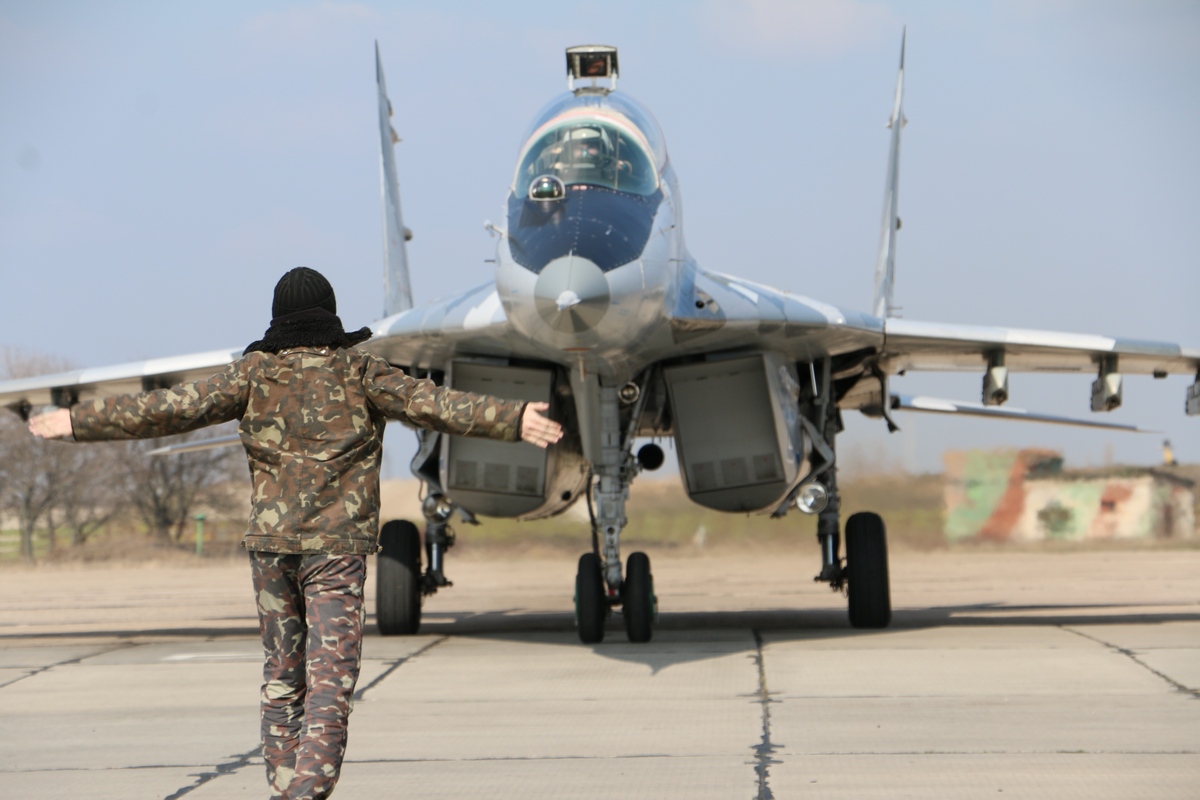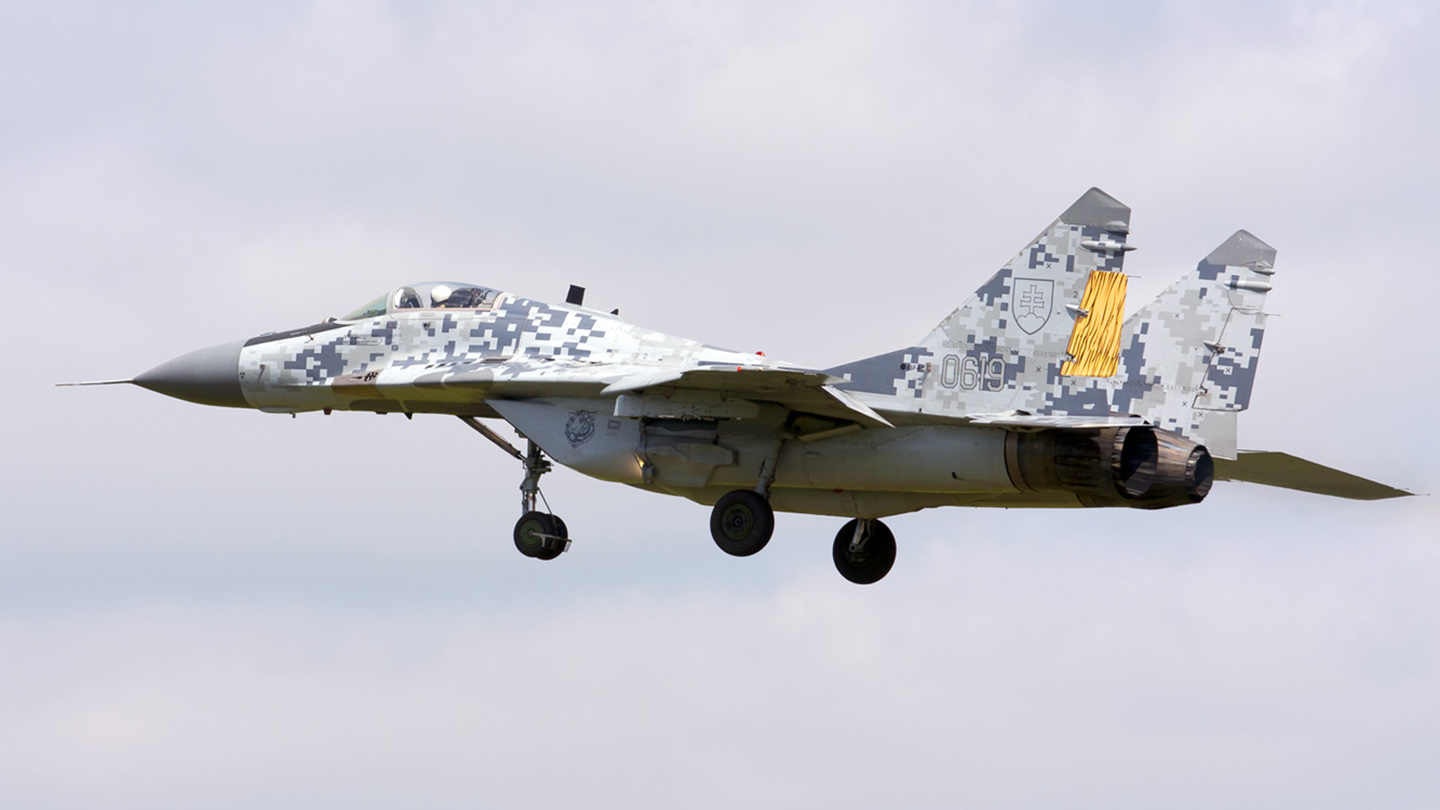Slovakia is on the verge of gifting its fleet of Mig-29 fighters to Ukraine, giving Kyiv an injection of familiar combat jets it has been clamoring for since Russia’s all-out invasion began five months ago to the day.
Jaroslav Nad, Slovakia’s defense minister, said on July 25 that the small former Warsaw Pact member is primed to discuss transferring its 11 MiG-29s to Ukraine. The jets are set to be grounded by the end of August, after which Slovakia’s skies will be patrolled by neighboring Czech and Polish jets.
Ukrainian pilots already fly the MiG-29 and so there would be little additional training needed to put Slovakia’s jets to immediate use. President Volodymyr Zelensky has pleaded with Western supporters to provide fighter aircraft but NATO members, led by the U.S., have thus far come up short, although they have donated parts that have helped put grounded Ukrainian fighters back in the air.
The small eastern European nation does not have the resources to go it alone in gifting the MiGs and will need allies to offer replacement fighters or cash in exchange for providing Kyiv with its aircraft, Nad said according to Sky News. Each of the aircraft is worth about $35 million, Nad was quoted as saying, although that is an absurdly high price for those aircraft.
Slovakia’s potential donation brings Ukraine one step closer to refreshing its fighter fleet, which has taken a beating in five months of fighting, as have the pilots flying them. Kyiv’s hope of receiving 28 MiG-29s from Poland was much publicized before the plan collapsed after the U.S. said it wasn’t interested in being the middle man for the deal. Such concerns have likely lessened now that numerous countries are sending advanced guided munitions and other weapons that Russia has condemned as offensive.

Slovakia is counting on F-16 jets from other NATO members that are adopting the F-35 Joint Strike Fighter and more modern jets to backfill its fighter capacity. Ukraine would welcome surplus western fighters, but training and maintenance requirements will likely not allow the country to effectively field U.S.- or European-built fighters for months or perhaps years. Still, as The War Zone pointed out in this previous story, there is no time to waste in preparing the Ukrainian Air Force to operate new fighters. The 2023 U.S. defense policy bill, passed by Congress earlier this month, includes a plan to train Ukrainian pilots on U.S. jets.
Much ink has been spilled over the possibility that the U.S. Air Force could donate the A-10 Warthogs it so badly wants to divest. The tank-killer aircraft was designed to provide close air support and anti-armor capability in exactly the sort of open-field European war currently being waged by Russian forces in eastern Ukraine, although its potential performance against the modern air defenses that Russia is fielding near the front lines is highly debatable. Still, senior USAF leaders left the door open for A-10 transfers to Ukraine just last week, but those aircraft also would still require time-consuming pilot and maintenance training.
While Kyiv continues to call for fighter donations, several ground combat systems already promised by Europe and the U.S. began to show up in Ukraine over the weekend. The war also entered its sixth month today, but before we get to the details, readers can catch up on our past rolling coverage here.
The Latest
Fighting continues in both the Donbas and Kherson regions of east and south Ukraine, though little has been gained by either side, according to the latest assessment of the war from the U.K. Ministry of Defense.
“Russian commanders continue to face a dilemma; whether to resource the offensive in the east or to bolster the defense in the west,” the U.K. MoD said.
More than 140 days into the war, Russian forces are struggling with high casualty rates and the attrition of its combat vehicle fleet, the U.K. assessment found. As many as 300 vehicles, including main battle tanks, armored personnel carriers, and wheeled support vehicles were recently found at a refit and repair shop 10 kilometers inside Russia.
“Russia likely continues to struggle to extract and repair the thousands of combat vehicles which have been damaged in action in Ukraine,” the MoD said.
Ukraine is by all accounts continuing to hold its own. The Ukrainian Ministry of Defense posted an inspirational message on social media to mark the occasion, highlighting “Ukraine’s resilience, bravery and strength” and “five months of Russia’s failure, hatred, and terrorism.”
The Institute for the Study of War think tank said on July 23 that it is likely Ukrainian forces are planning a counterattack in the southern Ukraine region of Kherson.
As of late July, there are about 38,000 Ukrainian women — 5,000 of whom are frontline soldiers — serving in the army, Ukraine’s Defense Ministry said. Casualty numbers are hotly contested on both sides of the conflict.
There is some evidence that Ukrainian officials are planning for hostilities to last a good while yet. Authorities in Kharkiv, for instance, have launched a program to build bomb shelters near city bus stops where residents can shelter from Russian artillery and missile strikes.
Meanwhile, Russian forces are seen in video footage from the region building pontoon bridges in Kherson where existing spans have come under Ukrainian fire. The structures would give the Russians logistical insurance for getting material and troops into Kherson but also provide potential paths for retreat. Russia has so far struggled disastrously with crossing rivers in Ukraine.
In its Monday intelligence assessment of the war, ISW concluded Ukrainian forces had damaged all three bridges into Kherson City within the past week, putting Russian supply lines into the region at risk. Russian media outlets confirmed the assessment in their own reports.
The white “invasion Z” marking that has become both a rallying symbol for Russian forces and a ubiquitous adornment on destroyed tanks and other vehicles has now been spotted scrawled on the sail of a Russian Navy submarine capable of carrying nuclear missiles. The sub is not anywhere near Ukrainian waters, of course, but the Z symbol has been seen on Russian vehicles all over its vast territory, seemingly in support of the war effort.
So far, the Russian Navy has not fared well in the Black Sea, where several of its capital ships have been sunk or badly damaged by Ukrainian air and missile strikes. Most recently, a Russian Raptor patrol boat was seen damaged near the country’s Novorossiysk Naval Base. The vessel appears to have nearly broken in half and is being hauled away on a barge, as seen in the below photos posted online on Sunday. TB2 drones struck Raptor-class boats during the battle for Snake Island last May. It isn’t clear if this is one of those boats possibly salvaged from the waters around the island, which is now back in Ukrainian hands.
Echoing the crowdfunding effort by Lithuania to purchase Ukraine a Bayraktar TB2 drone, Polish citizens recently raised 22.5 million zloty, or just over $4.8 million, to buy another one. The Ukrainian Ministry of Defense tweeted its thanks for the gesture and said it was “blessed to have a neighbor like you!”
Also joining the fight on behalf of Ukraine is at least one Mi-24V attack helicopter, which was donated by the Czech Republic. It has been seen lobbing unguided rockets at Russian forces in the east, as the video below shows. As the aircraft pulls out of the climb and banks in front of the camera, its green camouflage paint scheme and pair of white combat stripes on the tail boom are clearly visible.
Ukraine’s Minister of Defense Oleksii Reznikov on Monday confirmed that several Gepard self-propelled anti-aircraft vehicles had arrived in the country. Berlin has promised 15 of the systems, of which at least three are now in Ukrainian service, he said.
However, Germany has been extremely slow among NATO nations in providing Ukraine with weapons. On Saturday, Berlin delayed the planned delivery of 11 IRIS-T surface-to-air missile systems to Ukraine. The Federal Security Council, led by Chancellor Olaf Scholtz, held up Kyiv’s application for the weapons.
Germany, which imports much of its energy from Russia, is on the brink of crisis as Russian oil giant Gazprom has reduced the flow of natural gas through the Nod Stream pipeline. The Russian-state-owned company says gas flow would fall to about a 1/5th of the controversial pipeline’s capacity by the end of the week, according to the Kyiv Independent news service.
Russia appears to have lost at least a couple of its S-300 surface-to-air (SAM) launchers to Ukrainian fire in Kherson. Russia recently began firing the SAM system at ground targets using a little-known land attack capability.
There are claims that Russia used its artillery to strike two more schools in the east.
In a similar vein, after initially denying they struck the port city of Odessa one day after agreeing on a deal to allow grain shipments to leave the harbor, Russian now says it targeted military infrastructure there.
There is some speculation that Russia is suffering a shortage of long-range artillery ammunition both because it has fired a huge number of rounds at Ukrainian forces and because its ammunition depots have been effectively targeted by Ukrainian units. Ukraine said Monday its forces used U.S-supplied High-Mobility Artillery Rocket Systems, or HIMARS, to blow up 50 Russian ammo dumps in the past month.
As effective as those systems have been — and the U.S. is sending more — the Biden Administration is still wary of sending longer-range Army Tactical Missile Systems, or ATACMS, capable of firing 190 miles. That would put Russian positions inside Ukraine’s borders potentially under threat by U.S.-donated precision weapons. This is a capability Washington has said it does not wish to provide Ukraine due to concerns over an escalation into a wider conflict.
Still, the U.S. government is solidly behind Ukraine and taking further steps to hold Moscow accountable for the invasion and the conduct of its troops since February. On July 25, the U.S. Ambassador to Ukraine, Bridget Brink, said the U.S. is “seriously considering” naming Russia a state sponsor of terrorism, which Kyiv and other NATO heads of state have called for. This would be a major move against Moscow and could further the country’s economic isolation.
Still, Ukrainian positions along the frontlines in the east continue to come under heavy Russian artillery fire. Video footage appeared over the weekend of BM-21 Grad multiple-launch rocket systems raining incendiary munitions on Ukrainian forces in the Avdiivka area of Donetsk Oblast.
More video footage has appeared online showing another angle of the harrowing helicopter resupply and casualty evacuation missions Ukrainian special forces launched in Mariupol back in March. In the video, a Ukrainian Mi-8 helicopter is seen delivering shoulder-fired Stinger anti-aircraft missiles and Javelin anti-tank guided missiles to the city’s defenders. The helicopter’s crew also delivered medical supplies and Starlink satellite communication systems before evacuating wounded soldiers from the besieged Azovstol Steel Plant that has since fallen into Russian hands.
In small arms news, an M14 battle rifle showed up in use by a Ukrainian sniper over the weekend. Likely donated by one of the Baltic states, the M14, which the U.S. military largely ditched in favor of the M16 family of rifles during the Vietnam war but continued in service with sniper teams for decades after, is seen outfitted with a suppressor, modern optic, a bipod, and painted in woodland camouflage.
We will continue to update this post until we say otherwise.
Contact the author: Dan@thewarzone.com
